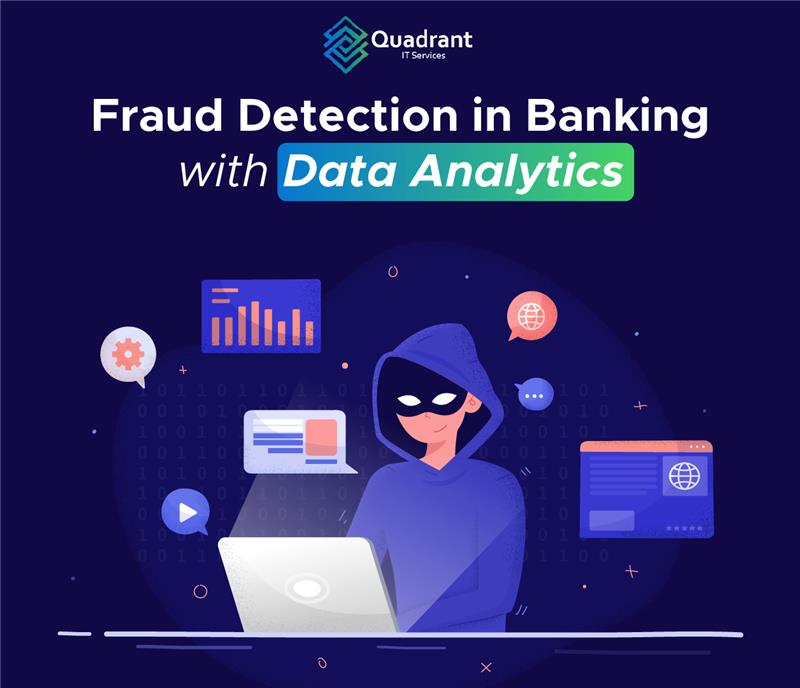Healthcare is transforming digitally, revolutionizing patient care with personalized approaches and accessible services. In this evolving landscape, Application Programming Interfaces (APIs) play a crucial role in facilitating seamless data exchange across the healthcare industry.
So, what exactly are APIs in healthcare, and how do they contribute to this transformative journey? In simple terms, APIs serve as intermediaries, enabling different software systems to communicate and exchange information efficiently. Much like how third-party APIs link travel booking sites with airline and hotel databases, healthcare APIs connect disparate systems within hospitals, pharmacies, laboratories, and more, ensuring seamless access to patient information.
In this blog post, we’ll explore the role of APIs in healthcare communication, their significance in facilitating real-time data flow, different types of APIs, their benefits, and why Quadrant IT Services is the ideal partner for implementing API solutions in healthcare.
Importance of Effective Communication in Healthcare:
Effective communication in healthcare is paramount, especially when every second counts. Timely access to accurate patient information, test results, and treatment updates is crucial for healthcare providers to make informed decisions and deliver optimal care.
API development services facilitate real-time data communication, enabling interoperability between electronic health records (EHRs), medical devices, laboratory systems, and other healthcare applications. Real-time data flow also enables healthcare providers to access up-to-date patient information instantly, allowing for quicker diagnoses, treatment decisions, and interventions.
For example, in emergencies, instant access to a patient’s medical history, allergies, and medication list can be life-saving. Furthermore, real-time monitoring of vital signs and remote patient monitoring devices ensures timely interventions and proactive care management, especially for patients with chronic conditions or those requiring continuous monitoring.
This overall seamless exchange of information ensures that healthcare professionals have access to the latest patient data when and where they need it, ultimately leading to improved clinical outcomes and patient satisfaction.
How APIs Help Healthcare Achieve Real-time Data Flow:
APIs play a crucial role in facilitating real-time data flow in healthcare by enabling seamless integration and interoperability between disparate systems and applications. For instance, healthcare organizations can use APIs to connect their EHR systems with telemedicine platforms, wearable devices, and patient portals, ensuring that patient data is consistently updated and accessible across the care continuum. Additionally, APIs allow for the secure exchange of data between healthcare providers, laboratories, pharmacies, and other stakeholders, enabling collaborative care delivery and improving care coordination.
Types of APIs in healthcare:
To understand APIs in Healthcare better, let us understand the three primary types of APIs:
- Internal Healthcare APIs: Developed within healthcare enterprises, internal healthcare APIs play a vital role in enhancing efficiency, interoperability, and the visibility of applications and digital tools. These APIs are often built on clinic management software, local storage servers, or patient-centered apps, allowing for better tracking and management of internal systems. Some healthcare organizations even make internal APIs available for public and partner consumption, further expanding their utility.
- External Healthcare APIs: External healthcare APIs are designed for use by external stakeholders such as partners, doctors, software developers, and insurance providers. These APIs enable seamless integration with third-party tools and services, enhancing the overall ecosystem of healthcare delivery. For instance, hospitals may deploy symptom checker APIs for external use, contributing to improved brand recognition and care outcomes.
- Third-Party APIs: Healthcare organizations leverage third-party APIs to augment their digital offerings for both providers and the public. These APIs, developed and maintained by external vendors, provide access to a wide range of functionalities and services. For example, healthcare insurance companies often integrate with popular fitness tracking APIs such as Google Fit, Samsung Health, or Fitbit. By syncing fitness activity data, these APIs enable users to earn rewards and discounts, promoting healthier lifestyles and incentivizing engagement.
Benefits of APIs in Healthcare:
Now that we have covered the main types of APIs, let’s dive into the benefits that APIs in Healthcare hold,
The adoption of APIs in healthcare offers several benefits, including:
- Improved Interoperability: APIs enable seamless integration and interoperability between disparate healthcare systems and applications, ensuring the smooth flow of data across the care continuum.
- Enhanced Patient Engagement: APIs empower patients to access their health information, schedule appointments, communicate with healthcare providers, and engage in their own care management through patient portals and mobile applications.
- Streamlined Clinical Workflows: APIs automate manual processes, streamline clinical workflows, and reduce administrative burden for healthcare providers, allowing them to focus more on patient care.
- Accelerated Innovation: APIs foster innovation by providing developers with access to healthcare data and functionalities, enabling the development of innovative applications, tools, and solutions that address specific clinical needs and challenges.
- Data-driven Decision-making: APIs facilitate the exchange of real-time data and analytics, enabling healthcare organizations to make data-driven decisions, optimize resource allocation, and improve operational efficiency.
Now, let’s understand these benefits from a real-life example:
Scenario:
Sarah, a 35-year-old professional, recently visited her primary care physician for a routine check-up. During the appointment, her doctor discussed the importance of ongoing monitoring for her chronic condition and recommended utilizing digital health tools to better manage her health between visits.
- Step 1: Improved Interoperability Sarah’s healthcare provider utilizes APIs to integrate various systems and applications within their practice, including electronic health records (EHRs), patient portals, and mobile health apps. As a result, all of Sarah’s health data, including lab results, medication history, and appointment schedules, is seamlessly accessible across these platforms.
- Step 2: Enhanced Patient Engagement With access to a patient portal powered by APIs, Sarah can log in securely from her smartphone or computer to view her health information, schedule appointments, request prescription refills, and communicate with her healthcare team. This convenient access to her health data empowers Sarah to actively manage her care and make informed decisions about her health.
- Step 3: Streamlined Clinical Workflows When Sarah requests a prescription refill through the patient portal, the API automatically notifies her healthcare provider’s office and updates her electronic medical record. This automated process eliminates the need for manual data entry and phone calls, streamlining administrative tasks for Sarah’s healthcare team and freeing up time for more meaningful patient interactions.
- Step 4: Accelerated Innovation As Sarah continues to engage with digital health tools, her healthcare provider leverages APIs to gather anonymized patient data from across their practice for population health management and research purposes. This data-driven approach allows the healthcare organization to identify trends, assess outcomes, and develop innovative strategies for improving care delivery and patient outcomes.
- Step 5: Data-driven Decision-making By leveraging APIs to exchange real-time data and analytics, Sarah’s healthcare provider can proactively identify gaps in care, monitor her progress remotely, and intervene promptly if any concerning trends or developments arise. This proactive approach to care ensures that Sarah receives personalized, timely interventions to optimize her health outcomes and overall well-being.
Challenges
While adopting APIs in healthcare offers significant benefits, it is not without its challenges. The healthcare industry faces several obstacles when it comes to embracing APIs and leveraging their full potential. Some of the key challenges include:
- Data Security and Privacy Concerns: Healthcare data is highly sensitive and subject to strict regulatory requirements, such as HIPAA. Ensuring the security and privacy of patient information when transmitting data via APIs is paramount. Healthcare organizations must implement robust security measures, encryption protocols, and access controls to safeguard patient data against unauthorized access, breaches, and cyber threats.
- Interoperability Issues: Despite efforts to standardize data formats and exchange protocols, interoperability remains a significant challenge in healthcare. Healthcare systems often use proprietary formats and standards, making it difficult to achieve seamless data exchange and integration between different systems and applications. APIs must support interoperability standards like FHIR (Fast Healthcare Interoperability Resources) to ensure compatibility and interoperability across diverse healthcare IT environments.
- Legacy Systems and Infrastructure: Many healthcare organizations still rely on legacy systems and outdated infrastructure that lack native API support or interoperability capabilities. Integrating APIs with legacy systems can be complex and costly, requiring extensive customization, data mapping, and middleware solutions. Healthcare organizations must invest in modernizing their IT infrastructure to support API integration services and facilitate seamless data exchange across disparate systems.
- Regulatory Compliance Requirements: The healthcare industry is subject to stringent regulatory compliance requirements, including HIPAA, GDPR (General Data Protection Regulation), and other data privacy regulations. Healthcare organizations must ensure that APIs comply with regulatory standards and adhere to data protection laws to avoid potential legal and financial repercussions. This includes implementing robust consent management mechanisms, data encryption, and audit trails to maintain compliance with regulatory requirements.
- Resistance to Change: Cultural and organizational barriers can hinder the adoption of APIs in healthcare. Resistance to change, lack of executive buy-in, and institutional inertia may impede efforts to embrace new technologies and modernize healthcare delivery models. Healthcare organizations must foster a culture of innovation, collaboration, and continuous improvement to overcome resistance to API adoption and drive successful digital transformation initiatives.
Despite these challenges, organizations are increasingly aware of the transformative potential of technology in improving patient care and operational efficiency. Yet, the intricacies of API development and managementcan pose challenges, leaving organizations uncertain about the best approach. Having an experienced IT partner by your side can make all the difference, providing the expertise and support needed to navigate these complexities and implement API solutions effectively. That’s where Quadrant IT Services steps in, as your trusted partner in developing APIs for the healthcare industry. Let us explore why in depth below:
Why Choose Quadrant IT Services for API Solutions in Healthcare
At Quadrant IT Services, we specialize in developing and implementing cutting-edge API solutions tailored to the unique needs of the healthcare industry. Our team of experienced developers, architects, and consultants possesses deep expertise in healthcare IT, interoperability standards, and API development. By partnering with us, healthcare organizations can benefit from:
- Customized API Solutions: We design and develop custom API solutions that align with your organization’s specific requirements, workflows, and goals.
- Seamless Integration: Our APIs seamlessly integrate with existing healthcare systems, EHR platforms, telemedicine solutions, and third-party applications, ensuring smooth interoperability and data exchange.
- Security and Compliance: We prioritize security and compliance, implementing robust authentication, encryption, and access control measures to safeguard sensitive healthcare data and ensure HIPAA compliance.
- Continuous Support and Maintenance: We provide ongoing support, monitoring, and maintenance services to ensure the performance, reliability, and scalability of your API solutions, allowing you to focus on delivering exceptional patient care.
Conclusion:
In conclusion, APIs play a transformative role in healthcare communication by facilitating real-time data flow, interoperability, and innovation. By leveraging APIs, healthcare organizations can enhance patient care, streamline clinical workflows, and drive operational efficiency. At Quadrant IT Services, we are committed to helping healthcare organizations harness the power of APIs to achieve their strategic objectives and deliver value-based care. Contact us today to learn how we can empower your organization with customized API solutions tailored to your unique needs and requirements.








